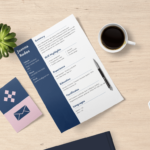Mastering the Art of Writing a Curriculum Vitae: A Step-by-Step Guide

Understand the Basics of Resume Writing
Crafting a professional resume that stands out is essential to secure your dream job. To do this effectively, it is important to structure it clearly and concisely, outlining your key skills, qualifications, and experiences.
Additionally, it is helpful to customize the resume to the particular job you are applying for, emphasizing the experiences and abilities that are pertinent to the position.
With a comprehensive understanding of the basics of resume composition, you can create an impactful document that will grab the attention of employers and help you stand out from the competition.
Creating a striking header can be a game-changer when it comes to your resume. This is the first thing employers will see, so it is essential to make a good initial impression. Ensure that your header contains your name, contact details, and any relevant professional titles or credentials.
It can also be beneficial to include a concise summary statement or objective that provides employers with a quick overview of your relevant skills and qualifications.
By constructing an effective header, you can guarantee that your resume will make a positive impact on employers and increase the possibility of an invitation to an interview for the job.
Choose a Resume Format
When crafting your CV, selecting the right format is an essential step in creating a professional document.
The way your information is presented and organized can make a big difference in how employers assess your qualifications, so it's important to think about your own experience, skills, and career goals when choosing the format that best suits you.
There are three main resume formats to consider: chronological, functional, and combination. Each of these formats has its advantages, and depending on your background and the job you're targeting, one may be more suitable than another.
Taking the time to understand the different formats and select the one that effectively showcases your strengths can significantly improve your chances of landing the job of your dreams.
When selecting a resume format, it's important to take into account the industry and position you're applying for.
Different industries have different resume expectations, and tailoring your CV to meet these can make a positive impression on employers.
For example, if you're applying for a creative role, an eye-catching and innovative format might give you an edge. On the other hand, if you're applying for a corporate role, a more structured and professional format may be more appropriate.
Knowing the expectations of your target industry and customizing your resume format accordingly can demonstrate your commitment and suitability for the job.
The amount and relevance of your work experience is also a factor to consider when choosing a format.
If you have a solid history of employment, a chronological format may be the most effective way to demonstrate this.
This format emphasizes your work history by listing your most recent positions first, allowing employers to see the progression of your career. Alternatively, if you're a recent graduate or transitioning to a new field, a functional format may be more suitable.
This format focuses on your skills and achievements, allowing you to emphasize transferable abilities and accomplishments that are pertinent to the position.
In addition to the chronological and functional formats, you can also opt for the combination format. This format combines both elements, allowing you to showcase your work experience and relevant skills in a way that highlights your qualifications for the job.
It provides flexibility and enables you to emphasize the aspects of your background that are most pertinent to the role you're applying for.
Ultimately, the key is to select a resume format that effectively presents your qualifications and draws attention to your strengths, increasing your chances of landing an interview.
Gather the Necessary Information
Creating an outstanding professional resume requires the gathering of essential information.
To make your resume stand out and highlight your abilities and experience, it's essential to compile information about your past job titles, employers, dates of employment, and a brief description of your responsibilities and successes in each role.
Additionally, it's essential to include information about your educational background, such as the names of the institutions attended, the acquired certifications or degrees, and any related coursework or projects.
Having this information on hand before starting your resume will ensure that you have the resources to assemble an extensive and persuasive document that emphasizes your qualifications and makes a positive impression on potential employers.
Assembling the necessary information for your resume also necessitates collecting details about any pertinent skills and successes that you have acquired throughout your career. This means recognizing and listing any specialized or technical abilities that are pertinent to the job you are applying for, like expertise in certain software programs or languages.
Also, it's important to include information about any noteworthy accomplishments, such as certifications, awards, or successful projects, that demonstrate your capabilities and add value to your resume.
By including these details in your resume, you can effectively demonstrate your unique qualifications and make a convincing argument for why you are the perfect candidate for the job.
When gathering the necessary information for your resume, it's important to make sure that all the details are accurate and up-to-date.
Take the time to check dates of employment, job titles, and educational credentials to make sure that there are no discrepancies or mistakes in your resume.
Additionally, consider reaching out to past employers or colleagues to acquire any additional information or recommendations that can bolster your qualifications.
By performing thorough research and double-checking your information, you can guarantee that your resume is reliable, credible, and professionally presented.
In conclusion, the gathering of essential information is a crucial step in creating a professional resume.
By amassing all the pertinent details about your work history, education, skills, and successes, you can craft a comprehensive and persuasive document that effectively showcases your qualifications to potential employers.
Taking the time to gather accurate and up-to-date information will ensure that your resume is believable and professionally presented, increasing your chances of landing your dream job.
Create a Header and Contact Information
Creating a polished resume begins with a striking header and contact information.
This section is imperative as it provides the employer with essential details so they can contact you. Incorporate your full name, telephone number, email, and professional social media accounts, if applicable. Employ a legible font to ensure the details are readable.
Furthermore, contemplate including a professional title or summary sentence that showcases your primary abilities and qualifications.
This will capture the attention of hiring managers and leave a strong first impression.
When forming the header and contact information section of your resume, it's essential to pay attention to the layout and formatting.
Make the header stand out by using a larger font size or bolding the text.
Place it at the top of the page to make it conspicuous. Organize the contact information in a clear and structured way, using bullet points or a table if necessary. Ensure the accuracy of your contact information to avoid any communication issues.
By crafting an efficiently designed header and contact information section, you will make it straightforward for employers to reach out to you and increase your chances of securing an interview.
The header and contact information section of your resume is the first thing employers see, so it's essential to make it professional and eye-catching. Begin by choosing a neat and clear font that reflects your personal style and corresponds with the overall design of your resume.
Contemplate using a larger font size for your name to make it stand out. Include your phone number, email address, and professional social media profiles like LinkedIn. Refrain from using personal or unprofessional email addresses.
Ensure your contact information is current and precise. By constructing a well-crafted header and contact information section, you will make a positive impression on potential employers and enhance your chances of getting noticed for job openings.
Write an Objective or Summary Statement
Creating a professional resume requires an effective objective or summary statement.
This section should provide employers with a brief overview of your qualifications and career goals, allowing them to quickly assess your suitability for the job.
When constructing this statement, strive to tailor it to the specific position you are applying for.
Showcase your most relevant skills and achievements that align with the requirements of the role, and be sure to incorporate powerful action verbs to demonstrate your impact in past positions.
Utilize keywords from the job description in your statement to increase your chances of passing through applicant tracking systems.
You might even consider using creative language and strong adjectives to capture the attention of hiring managers and make a lasting first impression.
The objective or summary statement should be prominently placed at the top of your resume, following your contact information. This section serves as a snapshot of your qualifications and sets the tone for the rest of the document.
When deciding between an objective statement, which focuses on your career goals, and a summary statement, which highlights your key qualifications, be sure to keep it concise and impactful. This is your chance to make a strong introduction and convince employers that you are the ideal candidate for the job.
Remember, writing an effective objective or summary statement is crucial to creating a professional resume. Highlight your unique selling points and demonstrate your value to potential employers.
By crafting a compelling statement, you can effectively capture the interest of hiring managers and increase your chances of landing an interview.
List Your Work Experience and Education
Detailing your accomplishments and professional qualifications on a resume is a vital step in the job search process. When crafting the work experience section, it is important to provide a comprehensive overview of past positions, noting any responsibilities, successes, and abilities acquired.
To demonstrate job progression, the information should be listed in reverse chronological order, with the most recent position first.
To further highlight your qualifications, the education section should list any relevant degrees, certifications, or courses. Notable awards, honors, and achievements should also be included to showcase your expertise.
By presenting this information in an organized manner, employers can easily assess your skills and determine if you are a suitable candidate for the role.
When constructing a professional resume, it is important to remain concise and focused.
Use bullet points to emphasize key responsibilities, accomplishments, and relevant skills in each position or educational venture.
By providing a clear, organized account of your experience and qualifications, you will be able to make a strong impression on potential employers.
Include Relevant Skills and Achievements
When crafting a professional resume, it is essential to include a section dedicated to highlighting your relevant skills and accomplishments.
This will provide potential employers with a clear understanding of your capabilities and increase your chances of being considered for the job.
To do this, first, identify the key skills and qualifications that the employer is seeking for the position you are applying for.
Then, tailor your resume to showcase these specific skills, providing concrete examples of how you have utilized them in previous roles or projects.
Alongside skills, it is important to display any achievements that are relevant to the job.
This could encompass the successful completion of projects or recognition and awards you have received.
By emphasizing your accomplishments, you demonstrate your proficiency and competence in the field, as well as your capacity to generate meaningful results.
Wherever possible, it is beneficial to quantify your achievements, such as through the use of numbers or percentages, to illustrate the impact you have made.
Including these details will give you a competitive edge and make you stand out from other applicants.
Proofread and Finalize Your Resume
In order to create a compelling and professional document, it's essential to dedicate time to the proofreading and finalizing of your resume.
Careful attention to detail is paramount here, as minor mistakes can leave a negative impression.
Therefore, be sure to thoroughly review your resume for any errors, inconsistencies, or sections that need to be improved.
It may be beneficial to obtain feedback from a trusted source, as this can provide a fresh perspective and assist in the identification of any problem areas.
Additionally, when finalizing the document, ensure that all sections are structured and presented in an organized manner.
Make sure your contact details are easily visible and accurate, and that the objective or summary statement concisely and relevantly summarizes your career goals.
Additionally, be sure to include any relevant skills and achievements that demonstrate your suitability for the job, and arrange the work experience and education sections in reverse chronological order.
After a final read-through to check for flow, accuracy, and errors, your resume will be ready to present to potential employers.
Taking the time to proofread and finalize your resume properly can ensure that it accurately reflects your abilities and increases your chances of landing the job.
With a well-crafted resume in hand, you are ready to embark on your journey towards your dream job. Good luck!
Leave a Reply




Related Posts